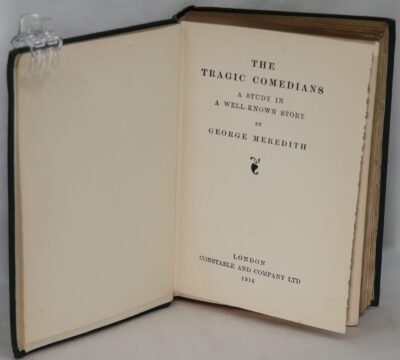The Bayeux Tapestry and the Norman Invasion.
By Lewis Thorpe
ISBN: LCCN:78315478
Printed: 1979
Publisher: Folio Society. London
| Dimensions | 20 × 26 × 2 cm |
|---|---|
| Language |
Language: English
Size (cminches): 20 x 26 x 2
Condition: Fine (See explanation of ratings)
Your items
Item information
Description
In a fitted box. Red cloth spine with gilt title. Navy and blue patterned paper boards with gilt King Harold image on the front board.
It is the intent of F.B.A. to provide an in-depth photographic presentation of this book offered so to almost stimulate your feel and touch on the book. If requested, more traditional book descriptions are immediately available.
The Bayeux Tapestry is an embroidered cloth nearly 70 metres (230 ft) long and 50 centimetres (20 in) tall that depicts the events leading up to the Norman conquest of England concerning William, Duke of Normandy, and Harold, Earl of Wessex, later King of England, and culminating in the Battle of Hastings. It is thought to date to the 11th century, within a few years after the battle. It tells the story from the point of view of the conquering Normans but is now agreed to have been made in England.
According to Sylvette Lemagnen, conservator of the tapestry, in her 2005 book La Tapisserie de Bayeux:
The Bayeux tapestry is one of the supreme achievements of the Norman Romanesque …. Its survival almost intact over nine centuries is little short of miraculous … Its exceptional length, the harmony and freshness of its colours, its exquisite workmanship, and the genius of its guiding spirit combine to make it endlessly fascinating.
The cloth consists of some seventy scenes, many with Latin tituli, embroidered on linen with coloured woollen yarns. It is likely that it was commissioned by Bishop Odo, William’s half-brother, and made in England—not Bayeux—in the 1070s. In 1729 the hanging was rediscovered by scholars at a time when it was being displayed annually in Bayeux Cathedral. The tapestry is now exhibited at the Musée de la Tapisserie de Bayeux in Bayeux, Normandy, France.
The designs on the Bayeux Tapestry are embroidered rather than in a tapestry weave, so that it does not meet narrower definitions of a tapestry. Nevertheless, it has always been referred to as a tapestry until recent years when the name “Bayeux Embroidery” has gained ground among certain art historians. It can be seen as a rare example of secular Romanesque art. Tapestries adorned both churches and wealthy houses in Medieval Western Europe, though at 0.5 by 68.38 metres (1.6 by 224.3 ft, and apparently incomplete) the Bayeux Tapestry is exceptionally large. Only the figures and decoration are embroidered on a background left plain, which shows the subject very clearly and was necessary to cover large areas.
The Norman Conquest (or the Conquest) was the 11th-century invasion and occupation of England by an army made up of thousands of Normans, Bretons, Flemish, and men from other French provinces, all led by the Duke of Normandy, later styled William the Conqueror.
William’s claim to the English throne derived from his familial relationship with the childless Anglo-Saxon king Edward the Confessor, who may have encouraged William’s hopes for the throne. Edward died in January 1066 and was succeeded by his brother-in-law Harold Godwinson. The Norwegian king Harald Hardrada invaded northern England in September 1066 and was victorious at the Battle of Fulford on 20 September, but Godwinson’s army defeated and killed Hardrada at the Battle of Stamford Bridge on 25 September. Three days later on 28 September, William’s invasion force of thousands of men and hundreds of ships landed at Pevensey in Sussex in southern England. Harold marched south to oppose him, leaving a significant portion of his army in the north. Harold’s army confronted William’s invaders on 14 October at the Battle of Hastings. William’s force defeated Harold, who was killed in the engagement, and William became king.
Although William’s main rivals were gone, he still faced rebellions over the following years and was not secure on the English throne until after 1072. The lands of the resisting English elite were confiscated; some of the elite fled into exile. To control his new kingdom, William granted lands to his followers and built castles commanding military strongpoints throughout the land. The Domesday Book, a manuscript record of the “Great Survey” of much of England and parts of Wales, was completed by 1086. Other effects of the conquest included the court and government, the introduction of the Norman language as the language of the elites, and changes in the composition of the upper classes, as William enfeoffed lands to be held directly from the king. More gradual changes affected the agricultural classes and village life: the main change appears to have been the formal elimination of slavery, which may or may not have been linked to the invasion. There was little alteration in the structure of government, as the new Norman administrators took over many of the forms of Anglo-Saxon government.
Lewis Guy Melville Thorpe FRSA FRHistS (5 November 1913 – 10 October 1977) was a British philologist and translator. He was married to the Italian scholar and lexicographer Barbara Reynolds. After service in Italy in the Second World War, Lewis Thorpe joined the staff of the University of Nottingham in 1946. He was Professor of French there from 1958 to 1977. He served as President of the British Branch of the International Arthurian Society and was a member of the Marylebone Cricket Club. Thorpe was born in Croydon. He died in Nottingham in 1977.
Want to know more about this item?

Share this Page with a friend












